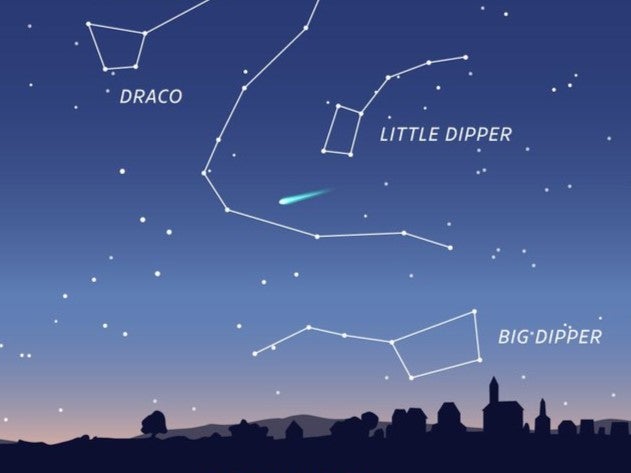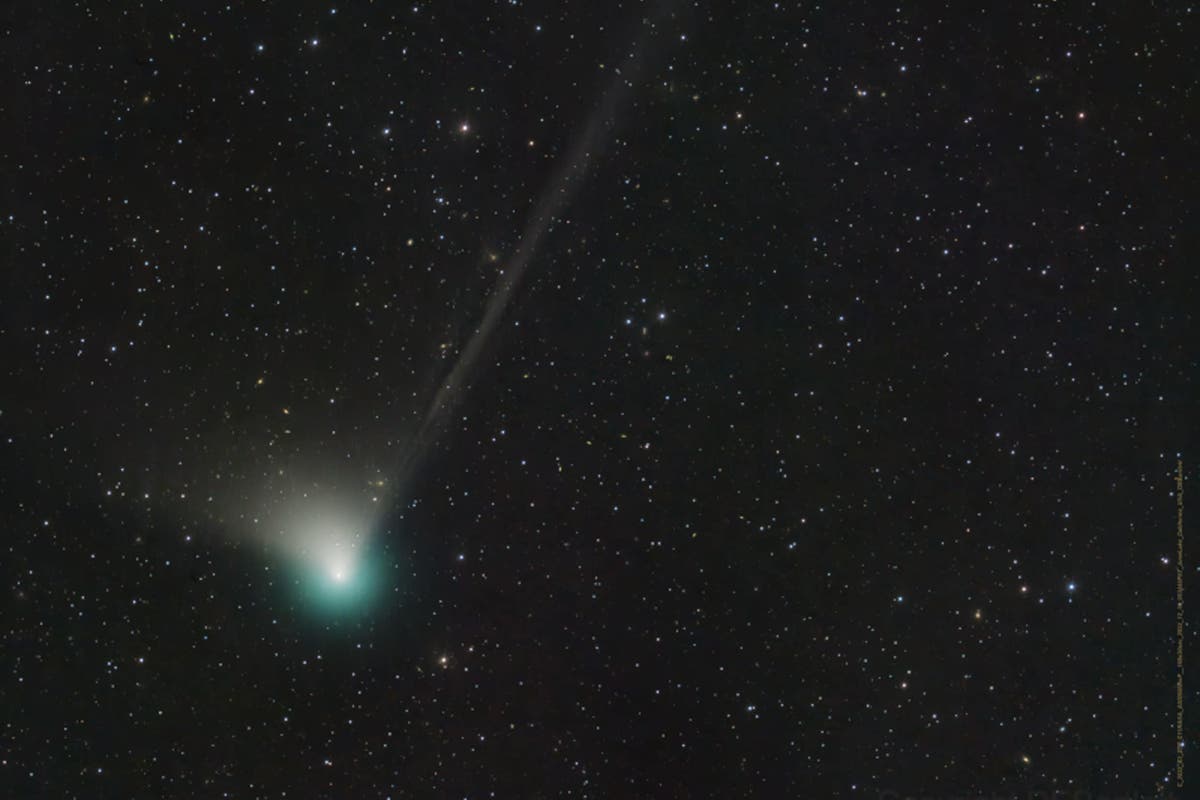Green comet 2023 – live: How to see E3 in sky tonight before it disappears forever
C/2022 E3 (ZTF) comet is visible with the naked eye from certain locations
Your support helps us to tell the story
From reproductive rights to climate change to Big Tech, The Independent is on the ground when the story is developing. Whether it's investigating the financials of Elon Musk's pro-Trump PAC or producing our latest documentary, 'The A Word', which shines a light on the American women fighting for reproductive rights, we know how important it is to parse out the facts from the messaging.
At such a critical moment in US history, we need reporters on the ground. Your donation allows us to keep sending journalists to speak to both sides of the story.
The Independent is trusted by Americans across the entire political spectrum. And unlike many other quality news outlets, we choose not to lock Americans out of our reporting and analysis with paywalls. We believe quality journalism should be available to everyone, paid for by those who can afford it.
Your support makes all the difference.A green comet is flying past Earth for the first time in 50,000 years, offering skygazers a one-off opportunity to witness the celestial spectacle before it disappears from our Solar System forever.
The C/2022 E3 (ZTF) comet made its closest approach to Earth on 1 February, 2023, but will continue to be visible throughout the week from anywhere in the northern hemisphere – weather permitting.
At a relatively close 42 million kilometres (26 million miles) from our planet, and with a brightness value of the magnitude of about +6, it will be possible to see it with the naked eye.
The comet is so rare that woolly mammoths and saber-toothed cats were still roaming the Earth when it last swept by our planet.
To find out where in the sky to look, and learn when conditions are best for viewing the comet tonight and over the next few days, you can follow our live coverage in the blog below.
How to spot green comet if you missed it today
The green comet is expected to slowly fade away from the skies over this week, but there will still be chances to get a glimpse of the cosmic entity over the following days.
The comet’s trajectory will take it past the bright star Capella on 5 February, before swinging by Mars on 10 February.
This graphic, made using Nasa and JPL-Caltech data, shows the path of the green comet as it passes through the solar system. (You can find an excellent indepth visual explainer on the comet right here.)
The Red Planet and the location of nearby stars and constellations might make it easier to spot.

With a full moon on 5 February, experts say the darker evening hours before moonrise in the coming days will be the best bet for spotting it in the sky.
Missed the comet? Don’t worry yet
The green comet hasn’t been past Earth for 50,000 years – and the experience of coming so close might mean that it never comes back again, as it will forever alter its orbit. 1 February was the important date, when it was closest to Earth and at its brightest.
However, if you missed it, don’t necessarily worry: next week might be the best time to see it after all. Around 10 February, the Moon will be less bright and the comet might actually be clearer, as it passes Mars.
You can find out more on that – and what else is going on in the night sky through the rest of the month – from Nigel Henbest, here.
What else is there to see this month?
If the arrival of the green comet has got your eyes turned upwards, it’s not the only thing you’ll see. There are other planets that are unusually bright and visible – and much more besides.
You can find out all the goings on in here, Nigel Henbest’s rundown of what’s going on in February’s night sky.
The 2023 ‘green comet’ is now visible from Earth for the first time in 50,000 years
The first comet to light up the night sky since the Neowise comet in 2020 is approaching Earth.
The E3 comet – also known as C/2022 E3 (ZTF) – is not just a once-in-a-lifetime event, it is a once-in-an-epoch spectacle that was last seen when Neanderthals still roamed the Earth 50,000 years ago.
The green comet passed within 26 million miles of Earth on 1 February; it is already visible to people in the Northern Hemisphere with binoculars or telescopes under the right viewing conditions.
Anthony Cuthbertson reports.

The ‘green comet’ is now visible from Earth for the first time in 50,000 years
Recently discovered comet C/2022 E3 is so rare that it was last seen during the Ice Age
Watch as a green comet flies by Earth
Watch as a green comet flew past Earth for the first time in some 50,000 years before disappearing from our Solar System.
The C/2022 E3 (ZTF) comet is so rare that woolly mammoths and saber-toothed cats were still roaming the Earth when it last swept by.
It was visible as it made its closest approach to Earth in the early hours of 1 February, 42 million kilometres away, and was seen again tonight.
While previous sightings have been through binoculars and telescopes, it’s expected to look so bright on Wednesday and Thursday that you could be able to see it with the naked eye.
More details in our full story.

Watch as a green comet flies by Earth
Watch as a green comet flew past Earth for the first time in some 50,000 years before disappearing from our Solar System.
How to track green comet over the week
Greenwich Royal Observatory says the green comet in its current close approach to Earth is near the constellation of Camelopardalis.
Then after its close approach, it will move through Auriga and end up in Taurus mid-February, the observatory noted.
On 10 February, the comet can be seen next to Mars after February’s full moon.
“The comet will dim over the month as it moves away from us, and the time that it will be up in the sky during the night will get shorter and shorter,” the Greenwich Royal Observatory said.
What studying comets has revealed in past
Astronomers study comets to understand their composition which can then yield insights on the conditions under which they formed.
Studying comets like ZTF, which are long-period comets have orbital periods longer than 200 years, can unravel mysteries about the origins of the Solar System.
Their chemical composition can also reveal secrets about how different molecules behave in the vastness of space under the influence of radiation from the Sun and other sources.
For instance, one such study 70 years ago, which assessed data on the motion of comet tails revealed the presence of the solar wind.
Until then the space between planets in the Solar System was thought to be almost empty.
But solar physicist Eugene Parker, inspired by research on comet tails, came up with the idea that constant wind emanates from the Sun.
Green comet 'failed to wow' astronomers observing in X-ray light
The European Space Agency tweeted that the green comet, that has not passed by Earth since Neanderthals roamed, has “failed to wow” those observing it in X-ray light.
ESA scientists attempted to study the comet using data from the XMM-Newton X-ray satellite, which has been in orbit since 1999, but said the comet barely showed up in the X-rays.
The results, however, are “scientifically very valuable,” the space organisation tweeted.
ICYMI: Green comet's discovery explained
The green comet, formally known as C/2022 E3 (ZTF), was discovered by astronomers from the Zwicky Transient Facility in March 2022.
Using the facility’s robotic camera and machine learning tools, astronomers first detected a moving object in a twilight survey while scouring through hundreds of images.
They initially thought it was an asteroid, but the space rock’s condensed coma and its projected path indicated it was a comet.
“On March 2nd, all we knew was that we had found a moving object. We reported it to the Minor Planet Center – they are the clearing house for these things,” Tom Prince, one of the lead scientists on the project, told The New Yorker.
“This particular object was spotted because of its motion in a sequence of images taken by ZTF,” Dr Prince said.
The comet, now at its closest distance to Earth, is predicted to disappear into the darkness of space, likely never to be seen by humans again.
ICYMI: How scientists solved mystery behind green shade of some comets
Several comets in history have been observed to glow with a greenish hue as they zoom past the Earth’s sky. However it had remained a mystery for decades why the green colour glow never reached these comets’ tails.
Although it had long been theorised that diatomic carbon (C2), created by the interaction of the comet dust with sunlight’s UV radiation may have been behind the glow, this hadn’t been tested till 2021 since the dicarbon molecule is very unstable.
Chemistry professor Timothy Schmidt from the University of New South Wales in Australia demonstrated in 2021 the process by which the dicarbon molecule is broken up by sunlight.
“The green colour comes from C2, which is itself a breakdown product of larger molecules in the snowball. The C2 breaks down into C atoms in a few days. The green is due to C2 absorbing and emitting light in a process known as fluorescence,” Dr Schmidt explained in a recent tweet.



Join our commenting forum
Join thought-provoking conversations, follow other Independent readers and see their replies
Comments